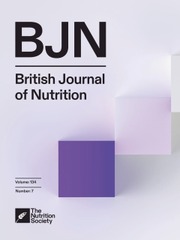No CrossRef data available.
Article contents
Absorption, accumulation and metabolism of cetoleic acid from dietary herring oil in tissues of diabetic male Zucker Diabetic Sprague Dawley rats
Published online by Cambridge University Press: 14 February 2025
Abstract
Accumulation of exogenous fatty acids such as the long-chain n-11 MUFA cetoleic acid (CA, C22:1n-11) may induce functional changes, through direct effects or by affecting the amounts of other fatty acids through changes in catabolic and anabolic processes including desaturation of fatty acids or by other processes. The primary aim of the present study was to investigate if dietary CA was absorbed and accumulated in a TAG-rich tissue for storage (white adipose tissue), a stable phospholipid-rich tissue (brain), metabolically active tissues (liver and skeletal muscle), or circulating in the blood (blood cells) and metabolised. Secondary aims included to investigate any effects on the levels of EPA and DHA. Eighteen male Zucker Diabetic Sprague Dawley rats were fed diets with herring oil (HERO) containing 0.70 % CA or anchovy oil (ANCO) devoid of CA, or a control diet with soyabean oil for 5 weeks. The HERO and ANCO diets contained 0.35 and 0.37 wt% EPA+DHA, respectively. Data were analysed using one-way ANOVA. CA from dietary HERO was absorbed, and CA and its chain-shortened metabolites were found in blood cells, liver, white adipose tissue and (WAT) and muscle, but n-11 MUFAs were not found in the brain. The concentrations of EPA and DHA were similar in liver lipids (TAG, cholesteryl esters and NEFA) as well as in WAT, muscle and brain from rats fed the HERO or ANCO diets. To conclude, CA was taken up by tissues but did not affect levels of EPA and DHA in this diabetic rat model.
- Type
- Research Article
- Information
- Copyright
- The Author(s), 2025. Published by Cambridge University Press on behalf of The Nutrition Society


